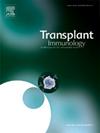柚皮素与青藤碱促进小鼠造血干细胞向未成熟树突状细胞分化促进移植免疫调节的比较效果
IF 1.4
4区 医学
Q4 IMMUNOLOGY
引用次数: 0
摘要
目的未成熟树突状细胞(imDC)是促进移植免疫调节的关键细胞。然而,imDC很容易成熟。青藤碱(Sin)柚皮素(Nar)是一种具有免疫调节和抗炎作用的中药。我们研究了Sin和Nar对小鼠未成熟树突状细胞(imDC)产生的影响及其延长同种异体皮肤移植物存活的能力。方法用Sin (Sin-HSC-imDC)或Nar (Nar-HSC-imDC)诱导从骨髓中提取的造血干细胞发育为未成熟树突状细胞(imDC)。采用细胞计数试剂盒-8 (CCK-8)法评估Sin-HSC-imDC与Nar-HSC-imDC的分化效果。流式细胞术检测DC表面标志物和脂多糖(LPS)处理后的凋亡,qPCR检测凋亡相关基因。通过混合淋巴细胞反应评估Sin-HSC-imDC和Nar-HSC-imDC对调节性T细胞(Tregs)产生的影响。采用酶联免疫分析法(ELISA)定量测定细胞因子的表达。通过Balb/c小鼠受体模型皮肤移植实验,评价sinc - hsc - imdc和Nar-HSC-imDC的免疫调节作用。Kaplan-Meier技术用于移植物存活结果。结果在体外实验中,与Sin-HSC-imDC相比,na - hsc - imdc具有更高的CD11c表达和更低的CD80作为imdc的标志物(P <;0.05),促进Tregs增殖的产生(P <;0.05)。白细胞介素2 (IL-2)和干扰素γ (IFN-γ)水平在Nar-HSC-imDC组降低(P <;0.05),但白细胞介素10 (IL-10)和转化生长因子β (TGF-β)水平升高(P <;0.05)。LPS处理后Nar-HSC-DC细胞凋亡率显著升高(P <;0.05)。在体内实验中,当Balb/c小鼠在皮肤移植前7天通过尾静脉接受Nar-HSC-imDC或Sin-HSC-imDC时,Nar-HSC-imDC组小鼠脾脏中CD4+CD25+CD127−Tregs的增殖增加(P <;0.05),明显延长了移植皮存活时间,且优于Sin-HSC-imDC组。结论nar诱导HSC向imDC分化的效果优于Sin。Nar-HSC-imDC诱导特异性免疫低反应性的能力强于Sin-HSC-imDC。本文章由计算机程序翻译,如有差异,请以英文原文为准。
Comparative efficacy of Naringenin and Sinomenine in facilitating the differentiation of mouse hematopoietic stem cells into immature dendritic cells to promote transplantation immunological regulation
Objective
Immature dendritic cells (imDC) are crucial in facilitating transplant immunological regulation. However, imDC is readily amenable to maturation. Sinomenine (Sin) naringin (Nar) are traditional Chinese medicine with immunoregulation and anti-inflammatory activities. We investigated the effect of Sin and Nar on the generation of immature dendritic cells (imDC) and their ability to prolong the survival of skin allografts in mice.
Methods
Hematopoietic stem cells (HSC) obtained from bone marrow prompted to develop into immature dendritic cells (imDC) through treatment with Sin (Sin-HSC-imDC) or Nar (Nar-HSC-imDC). The cell counting kit-8 (CCK-8) assay was employed to assess the differentiating efficacy of Sin-HSC-imDC and Nar-HSC-imDC. DC surface markers and apoptosis following lipopolysaccharide (LPS) treatment were assessed by flow cytometry, while apoptosis-related genes using qPCR. The impact of Sin-HSC-imDC and Nar-HSC-imDC on the generation of regulatory T cells (Tregs) was evaluated by mixed lymphocyte reactions. Cytokine expression was quantified using enzyme-linked immunoassays (ELISA). The immunomodulatory effects of Sin-HSC-imDC and Nar-HSC-imDC were evaluated by performing skin transplantation experiments in Balb/c mice recipients models. Kaplan-Meier technique was employed for graft survival outcomes.
Results
In vitro assays, in comparison to Sin-HSC-imDC, Nar-HSC-imDC had higher CD11c expression and lower CD80 as markers for imDCs (P < 0.05) and promoted the generation of Tregs proliferation (P < 0.05). Interleukin 2 (IL-2) and interferon gamma (IFN-γ) levels diminished in Nar-HSC-imDC groups (P < 0.05), but interleukin 10 (IL-10) and transforming growth factor-beta (TGF-β) levels elevated (P < 0.05). And the apoptosis rate of Nar-HSC-DC increased significantly after LPS treatment (P < 0.05). In vivo assays, when Balb/c mice received Nar-HSC-imDC or Sin-HSC-imDC via the tail vein seven days before skin transplantation, mice from the Nar-HSC-imDC group had increased CD4+CD25+CD127− Tregs proliferation in the spleen (P < 0.05), which prolonged skin graft survival, and that was better than in Sin-HSC-imDC group.
Conclusion
Nar was exposured more efficient in inducing differentiation of HSC into imDC than Sin. Nar-HSC-imDC had stronger ability in inducing specific immune hypo-responsiveness than Sin-HSC-imDC.
求助全文
通过发布文献求助,成功后即可免费获取论文全文。
去求助
来源期刊

Transplant immunology
医学-免疫学
CiteScore
2.10
自引率
13.30%
发文量
198
审稿时长
48 days
期刊介绍:
Transplant Immunology will publish up-to-date information on all aspects of the broad field it encompasses. The journal will be directed at (basic) scientists, tissue typers, transplant physicians and surgeons, and research and data on all immunological aspects of organ-, tissue- and (haematopoietic) stem cell transplantation are of potential interest to the readers of Transplant Immunology. Original papers, Review articles and Hypotheses will be considered for publication and submitted manuscripts will be rapidly peer-reviewed and published. They will be judged on the basis of scientific merit, originality, timeliness and quality.
 求助内容:
求助内容: 应助结果提醒方式:
应助结果提醒方式:


